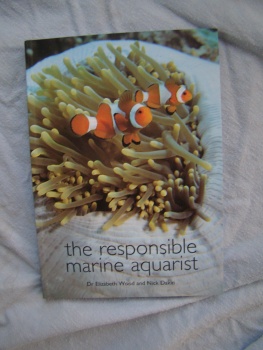
By Bob Goemans

TITLE: The Responsible Marine Aquarist
AUTHOR: Dr. Elizabeth Wood & Nick Dakin
PUBLISHER: Marine Conservation Society (2003).
ISBN 0-948150-36-X
PAGES: 154
PRICE: 24.95 US/£14.50 U.K. (Softcover)

There are many books available for marine hobbyists describing husbandry parameters for the wide range of animals maintained in closed systems. And most of these books are filled with hundreds of high quality photographs. However, practically none of these books adequately address or even mention the procedures involved in capturing or transporting these animals. Nor do they give much space to the over-exploitation of fish and invertebrates, destructive fishing practices, pollution, reef tourism, and/or laws being put into effect, or even the lack of adherence to present regulations. In other word, they paint a pretty picture, yet leave out the "dark side" of the hobby.
Finally, a book dedicated to everything that involves these animals prior to them arriving in your dealer's shop, and told in a professional, factual and honest fashion. One you will find fascinating and enlightening!
Like most books, it begins with a brief "Acknowledgements" where the authors thank those that made this publication possible. Following that, there are ten chapters, finishing with two quick reference guides, one pertaining to fish and the other to invertebrates.
Chapter One is titled "About This Book." It clearly, yet briefly states the goal of this work, which is to depict the challenges facing the industry and the impact to Mother Nature. And with 30 million tropical fish and hundreds of thousands of invertebrate being collected every year from 45 different countries, there's no doubt the impact to wild populations' needs to be more thoroughly addressed.
Chapter Two, "From Reef to Tank, How The Trade Works" is without question something all hobbyists should read. It mentions that well over 95% of marine specimens are still coming from the wild, who collects them, how some are collected, how they are treated once captured, and how they are shipped. Even though this is quite interesting, the next chapter, "Issues of Concern" brings to light over exploitation, methods that can damage the reef, and the cyanide problem! It also explores use of other drugs such as quinaldine, and mentions that even bleach, formalin, and gasoline are being used.
Chapter Four, "Essential Ingredients For Responsible Collecting And Trade" discusses ways to ensure sustainable collection and actions that need supporting, such as eliminating damaging collection methods, reducing mortalities and ensuring equality and fair trade. Chapter Five is titled "Regulations" and details the Convention on International Trade in Endangered Species (CITES). Something most hobbyists have heard about, but few understand its scope. Chapter Six, titled "Certification" is mostly dedicated to the effort that the Marine Aquarium Council is putting forth, and one which all hobbyists should support.
I found Chapter Seven, "A-Z of Supplying Countries and Management Practices" especially interesting as it provides a list and map of the 45 countries involve in the trade, and breaks them down into who is considered very large, large, medium-size, and small suppliers. Then rates them as to their level of management, i.e., none/minimal, some/reasonable, or good/fairly comprehensive.
Chapter Eight "Aquarium Species and Their Suitability" opens the door for the authors to state their general guidelines for getting started in the hobby and what to look for in the way healthy and maintainable species. In Chapter Nine, "Live Rock, Algae, and Invertebrates" the authors define associated aspects of each subject matter and where invertebrate is concerned, give numerous specific examples including photos, noting the pluses and minuses in each group of animals. In fact, each is subdivided into three sections noting which species are involved in the trade, their population status/ecology, and suitability for captive life. Chapter Ten, "Fish" does the same and covers just about everything normally seen in the trade. In fact, it has a Butterflyfish chart showing 90 species, which includes their scientific name, common name, and rates each as either "Hardy. Easy to transport and maintain, etc." or "May be delicate during transport and initial stages of captivity, etc." or "Difficult due to sensitivities or special requirements, etc." or "Extremely difficult to maintain, etc." or "Virtually impossible to maintain, etc."
Following the ten chapters there are two short 'quick reference charts' that provide guidance on how easy certain groups/families of fish or invertebrate are to maintain in captivity. One is called "Invertebrates at-a-glance" and the other "Fish at-a-glance." The book ends with Further Reading, General Index, Index of Scientific Names, Index of Common Names, and a very brief "About the Authors."
In conclusion, 'The Responsible Marine Aquarist' is well written, informative, and actually contains over 180 beautiful photos. And without question, the bulk of the work goes where most other books on the market don't go - the collection, transportation, regulation, environment, and what's sustainable in captivity. Honestly, an elegant and informative and truly inexpensive addition to your library. Furthering our knowledge in the hobby will not only benefit your present aquarium, it will broaden your horizon as to the scope of this industry. And that is a must, unless you want it quickly reduced to only what is currently available as propagated species.
And take note, since the availability of this publication in North America is lacking, I suggest visiting the Marine Conservation Society Website (www.mcsuk.org), as this book is worth the effort!